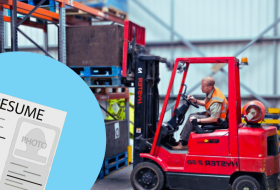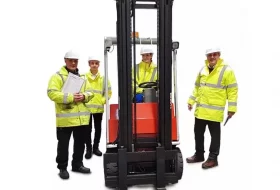As winter approaches, forklift operators face a unique set of challenges that demand special attention to safety and operational considerations. Operating a forklift in winter conditions presents a range of hazards and difficulties that can compromise both efficiency and safety. In this article, we will explore the challenges of driving forklifts in winters and discuss essential forklift safety measures to keep operators and their workplaces secure.
Challenges of Operating a Forklift in Winters
Slippery Surfaces:
One of the primary challenges for forklift operators during winter is dealing with slippery surfaces. Snow and ice on the ground can make it challenging to maintain traction, leading to accidents and potential injuries. To mitigate this challenge, it is crucial to ensure that the forklift’s tires are suitable for winter conditions. Many forklifts are equipped with solid rubber tires, which provide better traction on icy surfaces than traditional pneumatic tires. Additionally, using tire chains or snow studs can enhance grip and reduce the risk of sliding.
Reduced Visibility:
Winter weather often brings reduced visibility due to fog, snow, and icy conditions. Limited visibility can make it challenging for forklift operators to see potential hazards, other workers, or materials. To address this issue, it is important to equip forklifts with appropriate lighting and warning devices, such as strobe lights or backup alarms. Clearing snow and ice from the forklift’s windows and mirrors before operation is also crucial to maintain visibility. Additionally, operators should use caution and drive at a reduced speed to compensate for reduced visibility in winter conditions.
Cold Stress:
The cold temperatures of winter can lead to cold stress for forklift operators working in unheated warehouses or outdoor environments. Prolonged exposure to cold temperatures can result in reduced dexterity, numbness, and an increased risk of accidents. To combat cold stress, operators should be provided with suitable cold-weather gear, including insulated clothing, gloves, and headgear. Encouraging regular breaks in warm areas can help prevent cold stress and maintain operator well-being.
Battery Performance:
Electric forklifts rely on batteries for power, and winter weather can negatively impact battery performance. Cold temperatures can reduce a battery’s efficiency and overall capacity, leading to decreased forklift productivity. To address this challenge, forklift operators should ensure that batteries are adequately charged before use and consider using battery blankets or heated storage to maintain optimal operating conditions. It is also essential to keep spare batteries on hand to minimize downtime in case a battery needs to be swapped during the day.
Snow Removal:
Clearing snow and ice from work areas is a crucial aspect of forklift safety in winter. Accumulated snow can obstruct paths and reduce the available space for maneuvering, increasing the risk of collisions and accidents. Snow removal should be performed regularly to maintain clear and safe pathways for forklifts. This task can be managed through plowing, shoveling, or snow melting systems. It is vital to establish a snow removal plan and assign responsibilities to ensure a safe working environment.
Icy Slopes and Inclines:
In many workplaces, forklift operators need to navigate slopes, ramps, or inclines. These areas become especially hazardous in winter when ice and snow can make them slippery. Operating a forklift on an icy slope can result in the forklift tipping over, leading to serious accidents. To address this challenge, it is essential to equip forklifts with non-slip tire chains, use sand or ice melt to improve traction, and establish clear guidelines for forklift operation on inclines during winter.
Proper Training:
Forklift operators should receive specialized training that addresses the unique challenges of winter operation. This training should cover the handling of the forklift in slippery conditions, the use of snow chains or studs, and cold stress prevention. Ensuring that operators are adequately prepared for winter conditions is a crucial component of forklift safety in the colder months.
Maintenance:
Forklifts, like any other machinery, require proper maintenance, which becomes even more critical in winter conditions. The cold weather can exacerbate wear and tear on forklift components, potentially leading to breakdowns or failures. Regular maintenance checks should include inspecting hydraulic systems, lubricating parts, and ensuring that all components are functioning correctly. Additionally, it is essential to have a contingency plan in place for quick repairs or replacement in the event of a breakdown.
Forklift Safety in Winter
To address these challenges effectively and ensure forklift safety during the winter months, consider the following safety measures:
Pre-operational Checks:
Conduct thorough pre-operational checks before each shift, paying special attention to tire condition and tire pressure. Ensure that all forklift systems are in optimal working order.
Training and Certification:
Ensure that forklift operators have received comprehensive training and are certified to operate in winter conditions. Refresher courses and updates on safety practices are beneficial.
Slow Down:
In icy or snowy conditions, it is crucial to reduce driving speed and maintain a safe following distance. Quick stops and sharp turns should be avoided.
Maintain Clear Pathways:
Regularly remove snow and ice from work areas and pathways to ensure safe forklift operation.
Visibility:
Improve visibility by using suitable lighting and warning devices. Clear snow and ice from forklift windows and mirrors.
Cold Stress Prevention:
Provide operators with cold-weather gear and encourage regular breaks in warm areas to prevent cold stress.
Battery Maintenance:
Maintain forklift batteries by charging them properly and considering battery blankets or heated storage.
Follow Manufacturer Recommendations:
Adhere to the manufacturer’s guidelines for tire selection, maintenance, and the use of snow chains or studs.
Emergency Procedures:
Establish clear emergency procedures for winter operations, including protocols for responding to accidents, breakdowns, and incidents involving cold stress. Ensure all operators are familiar with these procedures and can respond effectively.
Adequate Lighting:
Proper lighting is crucial during the winter months, especially when daylight is limited. Invest in high-quality headlights, rear lights, and strobe lights to improve visibility and make the forklift more noticeable to other workers and vehicles in the vicinity.
Communication:
Effective communication between forklift operators and other workers is vital. Use two-way radios or other communication devices to keep everyone informed about the location of the forklift and any potential hazards.
Weather Forecast Monitoring:
Keep a close eye on weather forecasts and be prepared for sudden changes in weather conditions. Adjust work schedules or operations as needed to accommodate extreme weather events.
Additional Safety Training:
Conduct regular safety meetings to address winter-specific safety topics and remind operators of the importance of adhering to safety guidelines, especially in challenging conditions.
Supervision:
Increase supervision during winter operations, especially when forklift operators are working in potentially hazardous conditions. Supervisors should be readily available to provide guidance and support.
Documentation:
Keep detailed records of all maintenance and safety checks performed on the forklifts throughout the winter season. This documentation can be valuable for evaluating the effectiveness of safety measures and ensuring compliance with regulations.
Conclusion
Operating a forklift in winter conditions comes with a unique set of challenges, but with proper training, maintenance, and adherence to safety protocols, these challenges can be effectively managed. Prioritizing forklift safety in winter is essential to protect the well-being of forklift operators, minimize the risk of accidents, and ensure the efficient operation of the equipment, even in the harshest weather conditions. By addressing the challenges and implementing the recommended safety measures, businesses can maintain a safe and productive work environment throughout the winter months.







